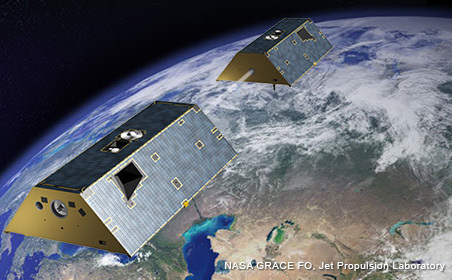A convergence of developments over the past few months has brought Europe’s Galileo program to the most critical passage of its history — at least, since final approval of the GNSS initiative by the European Space Agency (ESA) and the European Union (EU) in 2003 and 2004, respectively.
A convergence of developments over the past few months has brought Europe’s Galileo program to the most critical passage of its history — at least, since final approval of the GNSS initiative by the European Space Agency (ESA) and the European Union (EU) in 2003 and 2004, respectively.
This might, indeed, be the most difficult moment since the first tentative examination in 1993 of a European counterpart to the U.S. Global Positioning System. Although Galileo’s premature demise remains a distant prospect, statements at the March 6–8 Munich Satellite Navigation Conference and subsequent conversations with public and private officials indicate that the shape, schedule, and viability of the Galileo program may be at stake.
Here’s why.
At the beginning of 2006, the Galileo Joint Undertaking (GJU) — a rare fusion of European stakeholders — went out of business without having completed a contract with a consortium of eight private companies for a 20-year concession to complete and operate the Galileo system.
The GJU’s role had always been planned as a temporary one, focused primarily on the executing a concession contract. But it also has had responsibilities for letting and managing GNSS-related projects under the European Commission (EC) 6th Framework Program (FP6).
Those responsibilities have now been taken up by the European GNSS Supervisory Agency (GSA), a long-planned EC legal entity that was expected to merely sign the concession contract, own and oversee the Galileo infrastructure and operations on behalf of the public interest, and manage a variety of high-level tasks such as signal certification and system security. (The GSA, its roles, personalities, and plans will be explored more fully in a future issue of Inside GNSS.)
As the public pronouncements in Munich and later conversations made clear, however, some of those expectations have changed.
The in-orbit validation (IOV) phase and overall Galileo program are behind schedule due to technical and institutional issues — in itself, not an unusual situation for GNSS infrastructure projects in general. The second experimental satellite, GIOVE-B, experienced an electrical malfunction during testing that has delayed its launch until December.
Also not unexpectedly, the Galileo program is costing more than originally budgeted. More ominously, the concession negotiations — already over a year past the original completion date — have come to a standstill, and a general consensus exists that a contract will not be finished this year either.
Disconcerted Consortium
Probably the leading proximate cause is the inability of the consortium to incorporate a Galileo Operating Company (GOC) and appoint a chief executive officer (CEO). That situation, in turn, stems from a disagreement among consortium partners on an effort by the Spanish members, AENA and HispaSat, to expand their share in the allocation of work on implementation of Galileo.
Angling for a larger part of the Galileo business has been a common aspect of both the ESA and GJU contractual processes. However, numerous sources indicated that this effort, which some suggested may have Spanish political backing as well, departs from a key December 2005 agreement among consortium members and EU transport ministers regarding project shares.
But other factors are at play, too. Among these is the difficult issue of eliminating or at least adequately quantifying so-called design risks and reaching agreement on how these are to be shared among public and private partners.
Jean-François Bou, director of Thales Galileo program and acting CEO for the consortium, told the summit audience that there needs to be “full traceability between the mission requirements [established by ESA for the IOV phase] and the system requirements” under which the Galileo system will be completed and operated.
“A technical baseline is mandatory,” Bou said, adding that it remains unclear who will certify the system software and hardware, among other issues.
ESA is also experiencing strains with its private partner, the European Satellite Navigation Industries (ESNI, formerly Galileo Industries), which has the billion-euro contract for the IOV phase. Between 400 and 500 subcontracts had to be let simultaneously, and many remain unsigned. Consequently, some subcontractors have had to work without funds or even suspend Galileo activities.
Speaking Plainly
The situation brought some unusually blunt statements from EC officials during the plenary session of the Munich summit — public comments that took industry representatives aback.
Acknowledging that the concession negotiations have proved “more difficult than anyone anticipated,” Matthias Ruete, EC director general for energy and transportation, warned that “political patience is running short. Our political masters are expecting, and rightly so, for this program to go forward.”
The failure to incorporate the GOC also drew criticism from Pedro Pedreira, the GSA’s executive director, who told his Munich audience, “The consortium is not able to present its own terms, let alone negotiate those terms.”
In a later press conference, Pedreira added, “Downstream development [of Galileo-capable receivers and services] can’t happen without the certainty of system completion. We won’t have a reliable date [for completing the system] until a concession contract is signed.”
As Inside GNSS went to press, a March 22 meeting of the European Transport Council was expected to spend considerable time deliberating and evaluating the Galileo program, before giving guidance on the political way ahead. The council may also bring pressure on Spain to temper its commercial representatives in the consortium.
Ruete says the Transport Council will assess the program and set a clear timetable, including milestones that must be met to avoid potentially adverse actions. Asked if it was possible that the Galileo program might be stopped, Ruete noted, “A negotiator has to have alternative plans for success and a credible threat in terms of negotiations. We may have plans B, C, D, E, and F. Plan G, to stop Galileo, is the most improbable one.”
Ruete, who was the head of the EC’s GNSS unit for several years before leaving for another post in 2000, noted that he had left the Galileo program “when it was just a baby and have come back to find an unruly teenager.”
Despite such growing pains, Ruete said, “Galileo has faced crises in the past and has always found a way to move forward. This situation might be described as catharsis rather than crisis. We need a catharsis to find a way forward.”
Progress, Nevertheless
In fact, the Galileo program has continued to advance. Although they failed to achieve a full contract, the GJU and the consortium signed a so-called “head of terms” document last year outlining the sections of the contract and the areas of high-level agreement.
On March 2, ESA released the GIOVE-A Signal-in-Space Interface Control Document (SIS ICD). The document provides the technical details of the signals transmitted by the GIOVE-A satellite now in orbit.
Although the GIOVE-A SIS is different than the multiplexed BOC (MBOC) signal now expected to be transmitted at the L1 frequency, the ICD will enable receiver manufacturers and research institutions to use an actual Galileo signal for their research and development. The SIS ICD is available at the GIOVE web site.
ESA also has awarded a contract to UK-based Surrey Satellite Technology Limited to begin building a second spacecraft for Galileo. Named GIOVE-A2, the new satellite has an estimated value of €25 to €30 million and will use the company’s proven GIOVE-A technology.
Giuseppe Viriglio, ESA’s director of telecommunications and navigation, said ESA has used the delay in launch of GIOVE-B to prepare it to transmit MBOC signals, and that GIOVE-A and -A2 could as well.
Recently, ESA has allowed two GNSS manufacturers, Septentrio and NovAtel, to begin marketing Galileo receiver technology that those companies developed under program contracts.
Elsewhere in GNSS
Galileo’s difficulties are occurring during a very dynamic and swiftly changing international GNSS environment. China says it is moving to establish its own GNSS, Compass, even while it continues work on Galileo-related projects under an agreement with the EU.
Kehong Chen, vice-director of the Science and Technology Commission of Shanghai Municipality and member of a summit panel, expressed the Shanghai government’s support for Galileo and his belief that the 2010 World Expo in that city would be a “perfect stage” for demonstrations of Galileo products.
In response to a question about simultaneous Chinese development of Galileo and Compass, Chen said only, “Different kinds of systems can fulfill the requirements of different kinds of users.”
In the United States, the GPS III program is supposed to release a final request for proposals for space segment modernization within a matter of weeks, with industry responses due in the summer. A contract would come four to six months later, according to Col. Mark Crews, chief engineer of the GPS Wing (former Joint Program Office) at the U.S. Space and Missile Systems Center at Los Angeles Air Force Base. An RFP for the GPS III ground control segment has already gone out.
Meanwhile, Russia is accelerating restoration of the GLONASS system and considering addition of an interoperable CDMA signal. Sergey Revnivykh, a representative of the Russian Space Agency, said that two more launches, each with three GLONASS-M satellites, will take place this year, bringing the total number of healthy operational satellites in the constellation to 18.
Nineteen satellites are in the GLONASS constellation now, but three are in the process of decommissioning, three are being commissioned, and three are off-line for maintenance.
Copyright 2007 Gibbons Media and Research LLC





